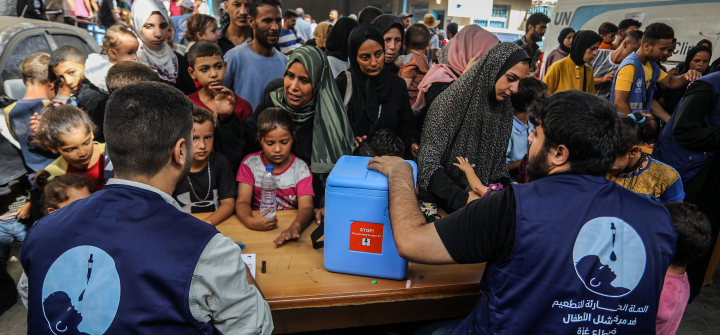Stopping Polio in Gaza and Why It Matters
Last week marked the end of a two month-long effort to protect over half a million children in Gaza from polio. During this time, thousands of health workers moved quickly during brief pauses in conflict to vaccinate children in tents, shelters, and health centers. They did this not once, but twice because each child needs at least two doses of the polio vaccine—ideally four weeks apart—to stop polio’s spread within and beyond Gaza.
Much of the world knows how important vaccines are for protecting against disease. With polio, the story is a bit more complex. To ensure this debilitating disease does not make a comeback globally, the world needs to understand how polio reappeared in Gaza, why multiple vaccination rounds are essential, and what global leaders can do.
The answer to how it reappeared is simple: war. Prior to the conflict, immunization rates for polio in Gaza were at exceptional levels (99%). However, coverage plummeted after it became nearly impossible for families to get their children vaccinated.
Now, here’s where it gets more complicated. The specific strain of polio in Gaza is type 2 variant poliovirus, a form of polio that can occur when not enough children are immunized. This happens when a child receives the oral polio vaccine (OPV) containing a live but weakened strain of poliovirus. When that child uses the bathroom, the vaccine virus enters the sewage system and can protect other children, especially in places with poor sanitation, as they too receive small doses of the vaccine virus. But there is a risk. If the vaccine virus transfers between enough un- or under-immunized children, it can revert to a form that causes paralysis and spread anywhere.
Eight years ago, the Global Polio Eradication Initiative (GPEI) —responsible for reducing polio cases by 99.9% since 1988—changed its vaccination strategy to limit the risk of this mutated strain. One hundred and fifty-five countries simultaneously switched from trivalent OPV (tOPV), containing all three types of polioviruses, to bivalent OPV (bOPV), which excludes type 2, the type responsible for most variant cases. This became known as “the switch.”
The switch happened based on the best available information. But parts of the world had lower immunity to type 2 poliovirus than the GPEI realized, and vaccine supply constraints combined with execution issues ultimately slowed the initial response to outbreaks. These challenges resulted in a surge of cases. In 2024, 31 countries are battling type 2 variant polio.
Fortunately, there’s a new vaccine, the novel oral polio vaccine type 2 (nOPV2), that is less likely to revert to a form that can cause paralysis. Over the three and half years of its use, the number of new variant polio cases has been reduced, giving us hope that the end of type 2 variant polio is in sight. This is the vaccine being used in Gaza.
The polio program has made mistakes, but it’s learning from the past. I was recently involved in a GPEI-commissioned evaluation of the switch to inform plans for the eventual withdrawal of bOPV. The results reaffirmed that all children everywhere need to be fully vaccinated against polio. This will require overcoming hurdles like war, climate disasters, political instability, and vaccine misinformation. Progress requires unwavering political support for vaccinations and the financial resources that make them possible.
We’ve seen the result of such commitment in Gaza. It’s now essential to get the same cooperation, resources, and determination to ensure no child is paralyzed by polio again. Polio anywhere is a risk to communities everywhere. Eradicating this devastating disease is in our shared humanitarian interest and essential for global health security.
Walter Orenstein, MD, is professor emeritus of Medicine, Pediatrics, Epidemiology, and Global Health at Emory University and formerly the associate director of the Emory Vaccine Center.
Join the 50,000+ subscribers in 170+ countries who rely on Global Health NOW summaries and exclusive articles for the latest public health news. Sign up for our free weekday newsletter, and please share the link with friends and colleagues.
A child is vaccinated during the polio vaccination campaign in Deir al Balah, Gaza, on September 1, 2024. Abed Rahim Khatib/Anadolu via Getty Images




